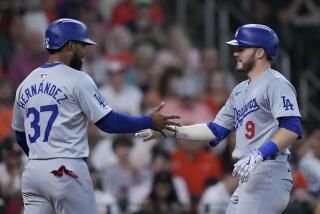There are two sides to a baseball deadline trade
When Tim Purpura was general manager of the Houston Astros he came to loathe the midseason trade deadline.
That may be one reason why Purpura is no longer general manager of the Houston Astros.
But at least his reasoning was sound.
Purpura, you see, hated the fact that the time and effort GMs put into building a competitive team in the winter, in spring training and in the first three months of the season could be wiped out in July, when a trade or two would change the entire complexion of the division — and the league.
“I’m sympathetic toward that view,” says Gerry Hunsicker, the man Purpura replaced in Houston.
As well he should be because Hunsicker is in Tampa Bay now, where as senior vice president for baseball operations he spends at least part of every summer watching the New York Yankees and Boston Red Sox try to sink the best-laid plans of his gutty little band of low-payroll Rays with a blockbuster trade or three.
But if Hunsicker has learned anything in his three-plus decades in baseball, it’s that the art of the deal is a lot like art in general: One person’s priceless masterpiece can be another person’s overpriced piece of junk.
Take last weekend, for example. The Yankees added $4.8 million to acquire slugger Austin Kearns and former All-Stars Lance Berkman and Kerry Wood.
The Rays? They got Chad Qualls, a soon-to-be 32-year-old reliever with a 1-4 record and a 8.29 earned-run average.
But if you think the Rays got had, Hunsicker would ask you to think again. They kicked the tires on a few deals, looked at Washington’s Adam Dunn and a few other bats. At the end of the day, Tampa Bay walked away knowing that sometimes the best trade is the one you didn’t make.
“We went fishing for some big fish. And when you do that, you know to begin with that the odds of pulling it off are not great,” Hunsicker says.
That can be a hard lesson for teams to learn. Especially at a time when every deal — and every non-deal — is immediately dissected on TV, on the Internet, in the newspapers and in the clubhouse.
Lost in all the instant analysis, however, is the fact that the real success of any trade must be measured over time. The biggest trade-deadline deal Hunsicker pulled off in Houston, for example, brought Seattle’s Randy Johnson to the Astros in 1998 for a trio of no-name minor leaguers. That was a no-brainer, right? A lopsided deal for Houston.
Or so everyone thought when the trade wound up costing Mariners General Manager Woody Woodward his job. But Johnson lasted only two months in Houston while two of those three minor leaguers ( Carlos Guillen and Freddy Garcia) blossomed into All-Stars who helped the Mariners to 116 wins three years later.
“When you’re doing this for a living, you have to first identify the objectives of the trade and then react accordingly,” says Hunsicker, who made the Johnson deal from home in his pajamas. “If you’re on the end of a trade where you are receiving minor league players, it takes a while to find out whether you were right.
“[If] you trade away a major league player that helps your trading partner win the World Series that year or not, that’s only their part of the equation. Your objectives were different.”
Tampa Bay’s objectives this year have been clear since spring training: Win the World Series. With four key players, including All-Stars Carlos Pena and Carl Crawford, eligible for free agency at the end of the season and four other starters eligible for arbitration, it could be years before the Rays are this competitive again.
Yet it also means Tampa Bay can’t afford to make a trade that would cost it any of its top minor league prospects who might fill such roster holes.
“It’s a juggling act,” Hunsicker says, “You’ve got to have one eye on the present and the other eye on the future. Especially with a smaller market [team], when you know you can’t go out and retool via free agency.
“If you’re going to make moves and use your farm system, you can’t go to the well on a consistent basis or you’re going to look up tomorrow and you’re to find yourself in last place and in a rather difficult hole to get out of.”
Being in a division that includes GMs like the Yankees’ Brian Cashman and the Red Sox’s Theo Epstein — and their checkbooks — doesn’t make it easy. But Hunsicker wouldn’t have it any other way.
“People wanted to talk about, ‘Oh, woe is me. We’re in the American League East. What a shame,’” he says. “But from [Manager] Joe Maddon’s first speech to the players in spring training, we embraced the fact that we were in the American League East because our goal is to be the best. And if you’re going to do that, you have to go through the best. So you might as well gear up for that and bring your ‘A’ game to work every day and get after it.
“Negative thinking … this business doesn’t have time for that. Just like losing a baseball game, if you sit and dwell on the game you just lost and you’re not prepared for the game you have to play tomorrow, chances are you’re going to be on the losing end of that one too.”
More to Read
Go beyond the scoreboard
Get the latest on L.A.'s teams in the daily Sports Report newsletter.
You may occasionally receive promotional content from the Los Angeles Times.











